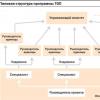New for 2015 – release of a CD for teaching Russian sign language "Let's get acquainted!". These are specially designed videos for hearing people who want to learn about Deaf culture and language.
The course was developed by specialists Center for Education of the Deaf and Sign Language named after Zaitseva.
Brief information about the deaf and hard of hearing.
- 100 most used gestures
- Video clips about the rules of communication with the deaf.
- Common phrases/dialogues used in communication.
The release of the disc became possible thanks to the VOG project “Let’s Preserve and Recognize the Diversity of the Russian Sign Language”, financial support was partially provided by the Russkiy Mir Foundation.
Chapter IT IS IMPORTANT contains gestures:
I
YOU
DEAF
HEARING
TRANSFER
TO HELP
BE IN LOVE
YES
NO
CAN
IT IS FORBIDDEN
HELLO
GOODBYE
THANK YOU
Chapter QUESTIONS contains gestures:
WHO?
WHAT?
WHERE?
WHERE?
FOR WHAT?
WHY?
WHERE?
WHICH?
WHOSE?
HOW?
WHEN?
Chapter WHO WHAT contains gestures:
WOMAN
MAN
HUMAN
MOTHER
DAD
HUSBAND WIFE)
FRIEND
DOCTOR
CAT
DOG
ADDRESS
MOBILE PHONE)
INTERNET
CITY
BUS
CAR
METRO
TRAM
TROLLEYBUS
MINISTRUTKA
TAXI
AIRPLANE
TRAIN
AIRPORT
RAILWAY STATION
SHOP
MARKET
BANK
HOSPITAL
POLICE
SCHOOL
JOB
Chapter WHAT DO WE DO? contains gestures:
EAT
WAS
DID NOT HAVE
WILL
WILL NOT
UNDERSTAND
DO NOT UNDERSTAND
KNOW
DONT KNOW
SPEAK
WRITE
WANT
DO NOT WANT
REMEMBER
DO
REPLY
ASK
Chapter HOW – WHAT? contains gestures:
FINE
BADLY
FINE
HURT
SLOWLY
FAST
FEW
A LOT OF
COLD
HOT
DANGEROUS
BEAUTIFUL
DELICIOUS
SMART
KIND
CALM
Chapter WHEN? contains gestures:
TODAY
YESTERDAY
TOMORROW
MORNING
DAY
EVENING
NIGHT
A WEEK
MONTH
YEAR
Chapter DACTYLOLOGY contains symbols of letters of the Russian alphabet.
Chapter NUMERALS contains designations of numbers.
Chapter LET'S TALK
I love you.
What is your name?
How old are you?
Do you study or work?
Where do you work?
I need a job.
I live in Russia.
Give me your address.
Send me an email.
I'll send you an SMS.
Let's go for a walk.
It is dangerous to ride a bicycle here.
Do you have a car?
I have a driver's license.
Do you want tea or coffee?
Be careful, the milk is hot.
I have a deaf son.
This is a good kindergarten for deaf children.
Do you have deaf teachers?
Parents of deaf children should know sign language.
My daughter is hard of hearing, she has a hearing aid, but she does not need a cochlear implant!
Good translators are needed everywhere.
I want to watch movies with subtitles.
There are many talented deaf artists and actors in Russia.
I need a translator.
Should you call a doctor?
Do you want to drink?
I like kids.
Let's go play.
Chapter IT IS NECESSARY contains phrases in sign language:
I am deaf.
I am hard of hearing.
I can not hear.
I know some signs.
Do you know sign language? – I don’t know gestures very well, but I know dactylology.
Can I help you?
Do you need an interpreter?
Where do you live?
Where are you from?
Where is the bus-stop?
The metro station is close.
I'm thirsty.
Where is the toilet?
This section provides rules for communicating with deaf people and simple dialogues in sign language.
RULES FOR COMMUNICATION WITH THE DEAF AND HARD OF HEARING PEOPLE
Rules for communicating with people with hearing impairments:
- look the interlocutor in the face, do not turn away during the conversation.
- do not raise your voice, but clearly articulate.
- use the services of a sign language interpreter.
- transmit information in writing by any means.
The main ways to attract the attention of the deaf and hard of hearing:
- pat on the shoulder.
- hand waving.
- knock on the table.
The disc also contains the brochure “What would you like to know about the deaf”, published by the Central Board of the All-Russian Society of the Deaf? International Day of the Deaf. It briefly summarizes general information about deaf people and how to communicate with them. The brochure is written primarily in a question-and-answer format, making it very easy to read.
How a dictionary works and how to use it
A short sign dictionary will help you, dear reader, master the vocabulary of sign speech. This is a small dictionary with about 200 gestures. Why were these particular gestures selected? Such questions inevitably arise, especially when the volume of the dictionary is small. Our dictionary was created in this way. Since the dictionary is intended primarily for teachers of the deaf, teachers and educators from schools for the deaf participated in determining the composition of the dictionary. For several years, the author offered students of the Moscow State University of Philology, working in boarding schools for the deaf, a list of gestures - “candidates” for the dictionary. And he turned to them with a request: to leave on the list only the most necessary gestures for a teacher and educator, and cross out the rest. But you can add to the list if required. All gestures to which more than 50% of expert teachers objected were excluded from the initial list. Conversely, the dictionary included gestures suggested by experts if more than half of them thought it was appropriate.
The gestures included in the dictionary are mainly used in both Russian sign speech and calque sign speech. They are grouped by topic. Of course, the attribution of many gestures to one topic or another is largely arbitrary. The author here followed the tradition of compiling thematic dictionaries, and also sought to place in each group gestures that denote objects, actions, and signs, so that it would be more convenient to talk on a given topic. At the same time, gestures have continuous numbering. If you, the reader, need to remember, for example, how the gesture INTERFERE is performed, and you don’t know what thematic group it is in, you need to do this. At the end of the dictionary, all gestures (naturally, their verbal designations) are arranged in alphabetical order, and the ordinal index of the INTERFERE gesture will make it easy to find it in the dictionary.
The symbols in the pictures will help you more accurately understand and reproduce the structure of the gesture.
Wishing you success in learning the vocabulary of sign speech, the author expects from you, dear reader, suggestions for improving a short sign dictionary.
Legend
GREETINGS INTRODUCTION

1. Hello 2. Goodbye

3. Thank you 4. Sorry (those)
GREETINGS INTRODUCTION

5. Name 6. Profession

7. Specialty 8. Who
GREETINGS INTRODUCTION

9. What 10. Where

11. When 12. Where
GREETINGS INTRODUCTION

13. Where 14. Why

15. Why 16. Whose

17. Man 18. Man

19. Woman 20. Child

21. Family 22. Father

23. Mother 24. Son

25. Daughter 26. Grandmother


27. Grandfather 28. Brother

29. Sister 30. Live

31. Work 32. Respect

33. Take care 34. Help

35. Interfere 36. Friendship

37. Young 38. Old
HOUSE APARTMENT

39. City 40. Village

41. Street 42. House
HOUSE APARTMENT

43. Apartment 44. Room

45. Window 46. Kitchen, cooking
HOUSE APARTMENT

47. Lavatory 48. Table

49. Chair 50. Wardrobe
HOUSE APARTMENT

51. Bed 52. TV

53. VCR 54. Do
HOUSE APARTMENT

55. Watch 56. Wash

57. Invite 58. Light
HOUSE APARTMENT

59. Cozy 60. New

61. Clean 62. Dirty

63. School 64. Class

65. Bedroom 66. Dining room

67. Director 68. Teacher

69. Educator 70. Teach

71. Study 72. Computer

73. Meeting 74. Deaf

75. Hearing Impaired 76. Dactylology

77. Sign language 78. Lead

79. Instruct 80. Execute

81. Praise 82. Scold

83. Punish 84. Check

85. Agree 86. Strict

87. Kind 88. Honest

89. Lesson 90. Headphones

91. Book 92. Notebook

93. Pencils 94. Telling

95.Speak 96.Hear



101. Know 102. Don’t know

103. Understand 104. Don’t understand

105. Repeat 106. Remember

107. Remember 108. Forget

109. Think 110. I can, I can

111. I can’t 112. Make a mistake

113. Good 114. Bad

115. Attentively 116. Correct

117. Ashamed 118. Angry, angry

119. Rude 120. Polite

121. Student

122. Diligent
ON A REST

123. Rest 124. Forest

125. River 126. Sea
ON A REST

127. Water 128. Sun

129. Moon 130. Rain
ON A REST

131. Snow 133. Day

132. Morning 134. Evening
ON A REST

135. Night 136. Summer

137. Autumn 138. Spring
ON A REST

139. Winter 140. Excursion, museum

141. Theater 142. Cinema
ON A REST

143. Stadium 144. Physical education

145. Competition 146. Participate
ON A REST

147. Win 148. Lose

149. Play 150. Walk
ON A REST

151. Dance 152. Want

153. Don't want 154. Love
ON A REST

155. Rejoice 156. Wait

157. Deceive 158. Cheerful
ON A REST

159. Agile 160. Strong

161. Weak 162. Easy
ON A REST

163. Difficult 164. Calm

165. White 166. Red
ON A REST

167. Black 168. Green
OUR COUNTRY

169. Homeland

170. State 171. Moscow
OUR COUNTRY

172. People 173. Revolution

174. Party 175. President
OUR COUNTRY

176. Struggle 177. Constitution

178. Elections, choose 179. Deputy
OUR COUNTRY

180. Chairman 181. Government

182. Translator 183. Glasnost
OUR COUNTRY

184. Democracy 185. War

186. World 187. Army
OUR COUNTRY

188. Disarmament

189. Treaty 190. Space
OUR COUNTRY

191. Protect 192. Politics
WHAT DO THESE GESTURES MEAN?

193, 194. Sign name (person's name in sign language)

195. Master of his craft 196. Master of his craft (option)
WHAT DO THESE GESTURES MEAN?

197. It doesn’t concern me 198. Make mistakes

199. Don’t catch me (at home, at work) 200. Amazing,
stunning

201. Same, identical 202. Calm down after
any disturbances

203. Exhausted 204. That's it
GESTURES OF SPOKEN SIGN LANGUAGE

205. Lose sight, forget 206. “Cats are scratching at the heart”

207. Don’t be afraid to say 208. Wait a little
something in the eyes
Index of gestures in alphabetical order
| army | do | ||
| grandmother | democracy | ||
| day | |||
| white | deputy | ||
| struggle | village | ||
| Brother | director | ||
| polite | Kind | ||
| agreement | |||
| right | rain | ||
| funny | house | ||
| spring | Goodbye | ||
| evening | daughter | ||
| video recorder | friendship | ||
| attentively | think | ||
| water | |||
| war | wait | ||
| teacher | woman | ||
| recall | sign language | ||
| elections, choose | live | ||
| fulfill | |||
| where is publicity deaf talk city state rude dirty walk dactylology grandpa | take care | ||
| forget | |||
| For what | |||
| protect | |||
| Hello | |||
| green | |||
| winter | |||
| angry, angry | |||
| know | |||
| play | |||
| excuse me (those) | |||
| Name |
| pencil | deceive | ||||
| apartment | window | ||||
| movie | autumn | ||||
| Class | rest | ||||
| book | father | ||||
| When | where | ||||
| room | make a mistake | ||||
| computer constitution space red bed who goes where kitchen, cook | |||||
| the consignment | |||||
| translator | |||||
| write | |||||
| Badly | |||||
| win | |||||
| repeat | |||||
| policy | |||||
| remember | |||||
| easily | to help | ||||
| forest | understand | ||||
| summer | entrust | ||||
| deft | Why | ||||
| moon | government | ||||
| be in love | chairman | ||||
| invite the president to check lose profession | |||||
| mother | |||||
| interfere | |||||
| world | |||||
| I can, I can | |||||
| young sea Moscow man wash | |||||
| work | |||||
| rejoice | |||||
| disarmament | |||||
| tell | |||||
| child revolution river draw Motherland scold | |||||
| punish | |||||
| people | |||||
| headphones | |||||
| dont know | |||||
| I can not | lead | ||||
| don't understand don't want a new night | |||||
| light | |||||
| family | |||||
| sister strong hearing impaired weak hear watch snow meeting agree sun competition bedroom thank you specialty calm stadium diligent old table dining room strict chair ashamed count son dance theater TV notebook difficult | restroom | ||||
| respect | |||||
| Street | |||||
| lesson | |||||
| morning | |||||
| participate | |||||
| teacher | |||||
| learn | |||||
| student | |||||
| study | |||||
| cosy | |||||
| physical education praise good to want | |||||
| whose man is black honest clean read that closet school excursion museum | |||||
How to learn sign language? This question has worried people for a long time, because there have been deaf and dumb people at all times.
It is more difficult for such people to adapt to society and to lead a full life. In the old days, in many European countries, people with hearing and speech impairments were not considered normal. They were sent to psychiatric hospitals for compulsory treatment. Society treated them negatively.
Before answering the question “how to learn sign language?”, let’s consider how the situation has changed over time and learn the background to the emergence of deaf pedagogy and dactylology.
Bonet system
Fortunately for the deaf and dumb, there were also positive-minded people who felt sorry for them and wanted to help. Such a person was, for example, the priest Juan Pablo Bonet. He lived at the beginning of the 17th century. One day, Bonet was hired as an assistant to a wealthy family, the head of which was an important official. This gentleman's son suffered from deafness; no one could teach him writing or arithmetic.
Soon the priest created his own training system for this boy. He came up with a special symbol for each letter in the alphabet. The question of how to learn sign language did not even arise with this deaf-mute boy; Bonet began to work with the child with enthusiasm and great enthusiasm.
Very soon the boy learned the entire alphabet. After this, rumors about the Bonet system spread throughout Spain. The priest published a book in which he described his method in detail.
School of Michel Charles de Lepeux

Michel Charles de Lepeux became famous for organizing and opening the world's first school for educating deaf and mute people. He took the book of Juan Bonet as the basis for his method. By the way, in Paris at that time there already existed a semblance of sign language in Old French. However, Michel de Lepe adapted this similarity into modern French, and communication between deaf-mutes began to consist of more than just individual words. Now people could communicate for real, build a smooth and coherent “speech”.
Thomas Hopkins Gallaudet School
Thomas Gallaudet, after visiting the de Leppe school, returned to the States and opened his own educational institution. The method was borrowed from a French colleague. At Thomas Gallaudet's school there were real "lectures" on how to learn sign language, adapted into English.

And again this method enjoyed great success and popularity.
Oralists opposed such a system of education. According to their beliefs, such a technique separates deaf people from the hearing community, and there is actually no benefit from it.
Alexander Graham Bell and his school of oralists

Here they taught writing and reading using a completely different system. Each speech sound (depending on the position of the lips) was marked with a written symbol. Initially, this method was supposed to be used to correct diction. But in the process, Bell taught the deaf and dumb in the same way.
The first deaf pedagogical schools in Russia
In 1806, the first school of deaf pedagogy was opened in Pavlovsk (near St. Petersburg). They taught here according to the French system.
In 1860, such a school opened in Moscow. In the capital, the German method was used as the basis for teaching how to learn sign language for deaf and dumb people.
Gradually, researchers and scientists began to appear in our country who were interested in such a training system.
Lev Semenovich Vygotsky

At first, he did not particularly believe in the benefits of sign language; he considered it very limited. But some time later, in one of his works, he called sign language extremely complex and diverse. The scientist considered it richly developed and recognized its undeniable benefits for deaf and dumb people.
Rachel Boskis and Natalia Morozova
We studied Vygotsky's works. In their work on speech development, they concluded that the grammar of simple Russian and sign language is different.
It was mistakenly believed that deaf people cannot learn sign language on their own, and also learn verbal speech at the same time.
Victor Ivanovich Fleury
He was a teacher and worked as a school director in St. Petersburg. He conducted a deep analysis of “deaf-mute speech” and came to the conclusion that sign language, Russian, can be learned by every person with hearing or speech impairment. In addition, he noticed that in certain companies and societies of the deaf, sign language has its own characteristics, differences and subtle patterns inherent specifically to that society. Just as in “our” (verbal speech) there is jargon and specific words, so in “silent speech” this is also present.
He wrote the book "Deaf and Mute". In this work, the teacher collected all the gestures and signs known to him.
There were other people who contributed to Russian education of the deaf: I. A. Sokolyansky, L. V. Shcherba, A. Ya. Udal.
So how do you learn silent sign language?
Let's look at this question in more detail. Below are step-by-step instructions.
Introduction to dactylology
First you need to get acquainted with dactylology. This is the name of a special form of speech. Dactylology includes the fingerprint alphabet. In it, each letter of the alphabet has its own designation - a sign made of fingers. These signs are called dactylems.

Many people are deeply mistaken that sign language and the dactyl alphabet are one and the same thing. There is a difference: dactylems convey words letter by letter, while sign language conveys whole words.
There is also manoral speech. With this form of communication, words are read from the lips, gestures only emphasize hard and soft, deaf and voiced consonants.
Finger placement technique
When learning the fingerprint alphabet, you should not rush. You need to remember well and practice the technique of placing your fingers. At first your hand will get tired. But after two or three workouts, your fingers will begin to get used to it and bend better.
Fingering speed
Having perfected the technique of forming dactyls, we move on to the speed of placing fingers. In deaf pedagogy, proper names, surnames, and geographical names are shown letter by letter.
The fingerprint alphabet can be found in the form of a picture or use a more visual video tutorial. By the way, sign language and dactylology are different in each country. Unfortunately, there is no single language for the deaf and dumb.
Practice
Having mastered all the dactylems, you should practice. Learn basic words, names or titles. Videos, films can help with this, there is even a special application for Android.
Counting and numbers
Once you have a little practice, you should master counting. It is advisable to immediately learn to show at least the simplest numbers. This will greatly advance the study of sign language.
Sequence of study
Let's move on to sign language itself. It contains about 2000 different symbols. How to quickly learn sign language with such a volume of signs? In fact, everything is not as difficult as it seems.

You should start learning gestures with simple words “hello”, “goodbye”, “sorry”, “thank you”. You should learn them gradually, without chasing quantity. It is better to learn a small number of gestures in one training session.
And the last recommendation. If you are seriously thinking about learning the language of the deaf, it may be worth looking for such courses in your city. They are not widespread, but you can still find them. Such courses are good because here you can get practice in live communication, hone your skills and language proficiency.
The language of the deaf is a hot topic for the deaf themselves and for their potential translators, that is, those who speak and hear well. And this is no wonder. In developed countries, there are three sign language interpreters for every deaf person. And if you calculate around the world, there are only three interpreters for every hundred deaf and mute people. Therefore, it is quite natural that sign language is of interest.
Types of language for the deaf and dumb
The problem of communication between people with hearing impairments has been known to mankind for a long time. And this language also had its revolutions, ups and downs.
- In the 18th century there was Amslen. His weakness was that he was constantly changing. Acquired many “dialects”. People had difficulty understanding each other.
- By the middle of the last century, there was a need for an international language for the hearing impaired. He appeared. They called him a rude name. It includes hand gestures, body turns and facial expressions.
Language for the deaf and dumb and its types
It is important to distinguish the language of the hearing impaired from dactylology. The last one is the image of individual letters with hands. It is used for proper names, city names, and specific words not yet included in the unified language.
Where to go to learn the language of the deaf and mute?
From the previous section it is clear: on the one hand, there is a fantastic need for sign language interpreters, on the other hand, no one is particularly eager to get into this profession. Answering the question why takes too long and is not very pleasant, so let’s immediately move on to the practical part - where to turn? The options are as follows.
- Groups and communities of the hearing-impaired and deaf-mute. The rescue of drowning people is the work of the drowning people themselves. Russian realities make many feel like Barons Munchausen. Of course, services of this kind are free.
- Educational institutions of both higher and middle levels. Available to social workers and linguists – free of charge.
- If suddenly the sufferers did not find free courses, then there are paid ones. They are provided by research and methodological centers, as well as special schools for the hearing impaired and the deaf.
When you don’t want to pay money (after all, this is not the most profitable investment), but there is a need for knowledge, then you should not despair. You need to turn to the great and mighty Internet, and it will tell you what to do.
How to learn deaf language on your own?
In general, real education is self-education. The world is fast and highly efficient, so there is often no time to get a systematic education when a person needs specific skills. Let's consider options for learning a language for the deaf and mute on your own.
- Websites. The Internet, as always, helps. A huge number of groups and communities that will help a person in theoretical and practical language acquisition.
- Phone applications. These are textbooks that do not take up much space and that can be opened at any time convenient for a person.
- Books. Despite technological progress and newfangled novelties, books are still popular among the population. What can I say, books and dogs are man’s best friends. But books are not made for lazy people. They need to be dealt with seriously and thoughtfully.
- Training video. Plus – visibility. The downside is that there is no mentor nearby to help if something goes wrong.
To understand whether a person speaks a language well or poorly requires practice. Therefore, as soon as the basics are mastered, you need to find a community where you can test yourself. And don't be afraid. If a person is hard of hearing, he will be welcome. If he has no hearing problems, then he will be doubly welcome, because there is a catastrophic shortage of sign language interpreters.
Our world is diverse. It cannot be said that there are people who are exactly alike, both externally and internally. Thus, another universe, which has its own properties, is also inhabited by those who are usually called deaf-mute people. Their perception of the environment is many times different from how a person who does not have such physical disabilities understands reality.
But it is important to note that the sign language of the deaf and dumb has the same versatility and colorfulness as that of a healthy person. The dictionary contains more than 2,000 gestures. And gesture signs are entire words, so showing and learning some of them will not be difficult.
Nonverbal sign language
Before getting into the dictionary of sign language, it would be appropriate to note that one of the misconceptions about it is that it depends on the verbal language that we use every day (sound and written) or that it allegedly originated from the latter, and even that the language of the deaf was founded by a hearing person. Moreover, it is generally accepted incorrectly that gestures of a silent language are accepted as fingerprinting of letters. That is, letters are depicted with hands. But that's not true.
In this language, dactylology is used to pronounce place names, specific terms and proper names. It is very easy to get acquainted with its basics since there is an established alphabet. And you will be able to easily communicate with a deaf-mute person by spelling out the word using gestures. Sign language for the deaf in Russian dactylology has 33 dactyl signs.
Sign language lessons
More detailed information about the language of the deaf and mute can be found in the book by G.L. Zaitseva. "Gesture speech" Here is a more detailed look at the most common gestures.

If you are asking the question: “Do I, a healthy person, need to know such a language?”, the answer is simple - sometimes there is not a lot of knowledge, sometimes it is not in demand. But perhaps one day, thanks to them, you will be able to help, for example, a lost deaf-mute.














